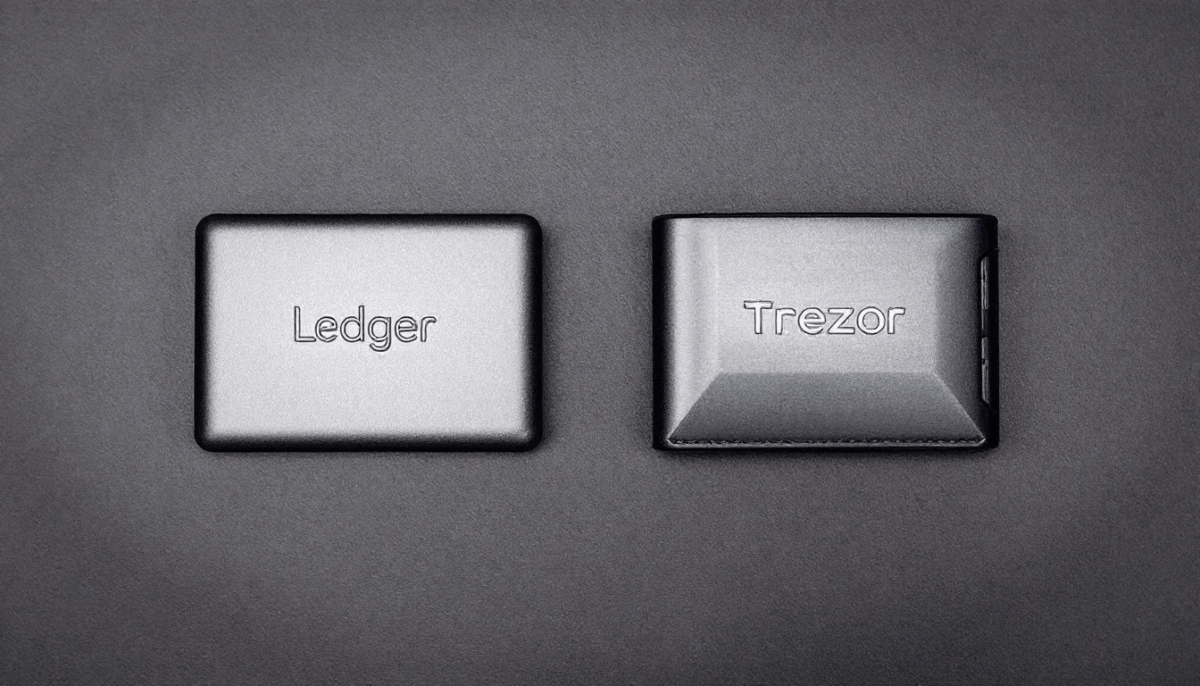Security is paramount as cryptocurrency hacks and phishing attacks continue to rise in 2025, hardware wallets like Ledger and Trezor remain the gold standard for safeguarding your digital assets offline.
Both Ledger and Trezor are industry leaders in cold storage solutions. Trezor offers affordable hardware wallets with a user-friendly interface and mobile app, making it an attractive option for beginner investors. On the other hand, Ledger stands out for its comprehensive staking experience and robust integration with the Ledger Live application, providing broader support for cryptocurrencies and making the management of digital assets more accessible and secure.
In this guide, we break down Ledger vs Trezor across critical areas to help you choose the right one for your needs.
Quick Comparison Table: Ledger vs Trezor
Feature | Ledger Nano X/Nano S Plus | Trezor Model T/One |
Security Chip | Secure Element (CC EAL5+ Certified) | General-purpose MCU (no Secure Element) |
Open Source Firmware | Partially Open Source (apps open-source) | Fully Open Source |
Supported Coins | 5,500+ cryptos | 1,200+ cryptos |
Mobile Compatibility | Via Bluetooth (Nano X) & USB (S Plus) | USB only |
Backup Options | Standard 24-word backup | Shamir Backup & Standard 24-word |
User Interface | Physical buttons & mobile pairing | Touchscreen (Model T), buttons (One) |
NFT Support | Via Ledger Live & third-party apps | Via Trezor Suite & third-party apps |
Price Range (2025) | $79 – $149 | $69 – $219 |
Best For | Mobile users, advanced security needs | Transparency lovers, open-source purists |
Key Differences Between Ledger and Trezor (2025)
Security Architecture and Enhanced Security
- Ledger uses a Secure Element chip (CC EAL5+ certified), similar to the chips used in passports and credit cards. This chip isolates private keys from your device’s OS and ensures tamper resistance.
- Trezor, while fully open-source, uses a general-purpose MCU and relies on transparent software and passphrase protection instead of Secure Elements. While Trezor is secure, there have been incidents where attackers with physical access to Trezor devices exploited vulnerabilities.
Verdict: Ledger offers slightly stronger physical key protection, but Trezor emphasizes software transparency.
Firmware and Transparency
Ledger’s firmware is proprietary, though many apps and tools are open-source. Trezor is fully open-source, giving tech-savvy users the ability to audit everything. Trezor’s commitment to open source principles ensures transparency and allows for public verification of its code.
Verdict: Trezor wins for open-source and transparency lovers.
Supported Crypto Assets
Ledger supports over 5,500+ assets, including obscure altcoins and NFTs.
Trezor supports 1,200+ assets, covering major coins and some DeFi/NFT support via third-party apps. Trezor requires third-party integrations for certain features like staking and NFT management.
Verdict: Ledger has broader coin support.
Mobile & Usability
- Ledger Nano X supports Bluetooth, enabling mobile management via the Ledger Live app. Ledger’s mobile apps, particularly Ledger Live, offer comprehensive functionality for managing cryptocurrencies on mobile devices.
- Trezor only supports USB connections, no Bluetooth. Trezor’s mobile apps are more limited, focusing mainly on balance monitoring.
Verdict: Ledger is better for on-the-go mobile users.
Backup & Recovery Options
- Ledger uses standard 24-word recovery phrases.
- Trezor Model T offers Shamir Backup, allowing users to split recovery phrases into multiple parts for extra security.
- Ledger also offers features like Ledger Recover to restore access if the Secret Recovery Phrase is lost or damaged.
Verdict: Trezor wins with more advanced backup features.
User Experience & Interface
Ledger devices use physical buttons for navigation. Trezor Model T offers a touchscreen, making it more intuitive for beginners. Trezor’s touchscreen provides an intuitive interface that simplifies the process of handling crypto assets, making it appealing for those new to cryptocurrency.
Verdict: Trezor Model T is slightly more user-friendly due to touchscreen.
Pros & Cons of Ledger and Trezor
Ledger Nano X/Nano S Plus | Trezor Model T/One |
|---|---|
Pros | Pros |
Uses Secure Element chip (high physical security) | Fully open-source firmware |
Supports over 5,500 cryptocurrencies | Shamir Backup support (Model T) |
Bluetooth for mobile usage (Nano X) | Touchscreen (Model T) |
Works seamlessly with Ledger Live app | Supports DeFi & NFTs via Trezor Suite |
Strong security features, including the use of a secure element chip | |
Cons: | Cons: |
Partially closed firmware | No Secure Element chip |
Slightly more expensive (Nano X) | Supports fewer cryptocurrencies |
Past security incident (Ledger 2020 data leak)* | No Bluetooth, USB-only |
Trezor device does not natively support NFTs, requiring third-party wallets for management |
*Note: Ledger had a database breach in 2020 affecting user emails, but private keys remained secure.
Which Wallet Is Safer in 2025 Against Physical and Digital Threats?
Use Case | Recommended Wallet |
|---|---|
Maximum physical key security & mobile use | Ledger Nano X |
Open-source lovers & software transparency | Trezor Model T |
Budget cold storage | Ledger Nano S Plus or Trezor One |
Best for NFT & DeFi users | Both (via third-party apps) |
Most supported coins | Ledger Nano X |
Best backup options | Trezor Model T (Shamir Backup) |
When it comes to crypto security, Ledger’s hardware security provides significant protection against physical attacks. On the other hand, Trezor’s open-source approach, while transparent, may pose vulnerabilities to physical attacks.
Ledger vs Trezor – Which Should You Choose?
- Choose Ledger if you want top-notch physical key security, mobile pairing, and maximum coin support.Ideal for users who want robust hardware security and seamless mobile management. Ledger is also a good choice for users who are buying crypto and need a wallet that supports a wide range of cryptocurrencies.
- Choose Trezor if you value transparency, open-source software, and advanced backup methods like Shamir.Ideal for privacy-conscious users, developers, and those who prioritize openness over hardware-level security. Trezor is a good choice for users who prioritize transparency and prefer non custodial wallets.
What are Crypto Wallets?
Crypto wallets are essential tools in the world of digital assets, acting as secure storage solutions for cryptocurrencies and NFTs. These wallets allow users to store, send, and receive crypto assets, ensuring that their investments are safe from both physical and digital threats. Among the various types of crypto wallets, hardware wallets like Trezor and Ledger stand out for their enhanced security features. By storing private keys offline, these wallets provide a robust defense against hacking attempts and malware. In this section, we will delve into the basics of crypto wallets, exploring their types, features, and the critical role they play in safeguarding your digital wealth.
Hot Wallets and Cold Wallets
When it comes to storing your crypto assets, you have two primary options: hot wallets and cold wallets. Hot wallets, also known as software wallets, are connected to the internet and store private keys online. This makes them convenient for frequent transactions but also exposes them to online threats such as hacking and phishing attacks. On the other hand, cold wallets store private keys offline, offering a more secure solution for long-term storage. Hardware wallets like Ledger and Trezor are prime examples of cold wallets, boasting robust security features such as secure element chips and physical buttons. These features ensure that your private keys remain safe from unauthorized access. In this section, we will explore the differences between hot and cold wallets, highlighting their respective advantages and disadvantages.
Crypto Wallets and Staking
Staking is an increasingly popular way for crypto users to earn rewards by holding and validating certain cryptocurrencies. Crypto wallets, especially hardware wallets like Ledger and Trezor, play a pivotal role in this process. These wallets provide a secure environment for storing private keys and managing staking operations. For instance, Ledger offers a user-friendly interface for staking, allowing users to earn rewards on a variety of cryptocurrencies through its Ledger Live app. Trezor, while supporting staking for a limited number of cryptocurrencies, offers a more transparent and open-source approach. In this section, we will examine the relationship between crypto wallets and staking, discussing the benefits and limitations of staking with different types of wallets.
By following this structured approach, the new sections will seamlessly integrate into the existing article, providing readers with comprehensive insights into crypto wallets, their types, and their functionalities.
Frequently Asked Questions (FAQs)
Is Ledger safer than Trezor in 2025?
Ledger offers better physical key isolation via its Secure Element, but Trezor provides full transparency with open-source software. Both are secure, but the choice depends on your priorities. Trezor stands out for its simplicity, open-source transparency, and user-friendly security features.
Can both wallets store NFTs in 2025?
Yes. Both Ledger and Trezor support NFTs via third-party wallets like MetaMask and their respective apps (Ledger Live, Trezor Suite). Ledger offers an integrated experience for NFT management through its Ledger Live app.
Does Trezor support as many coins as Ledger?
No. Ledger supports over 5,500 assets, while Trezor supports around 1,200+ as of 2025.
Has Ledger improved since its 2020 data leak?
Yes. Ledger has implemented tighter data privacy policies and no longer stores user emails or personal data by default.








